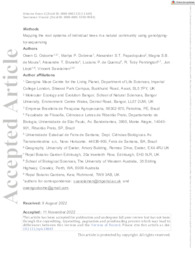Mapping the root systems of individual trees in a natural community using genotyping-by-sequencing
Mapping the root systems of individual trees in a natural community using genotyping-by-sequencing
Autoria: OSBORNE, O. G.; DOBREVA, M. P.; PAPADOPULOS, A. S. T.; MOURA, M. S. B. de; BRUNELLO, A. T.; QUEIROZ, L. P. de; PENNINGTON, R. T.; LLOYD, J.; SAVOLAINEN, V.
Resumo: The architecture of root systems is an important driver of plant fitness, competition and ecosystem processes. However, the methodological difficulty of mapping roots hampers the study of these processes. Existing approaches to match individual plants to belowground samples are low-throughput and species-specific. Here, we developed a scalable sequencing-based method to map the root systes of individual trees across multiple species. We successfully applied it to a tropical dry forest community in the Brazilian Caatinga containing 14 species We sequenced all 42 individual shrubs and trees in a 14 by 14 m plot using double-digest restriction-site associated sequencing (ddRADseq). We identified species-specific markers and individual-specific haplotypes from the data. We matched these markers to ddRADseq data from 100 mixed root samples from across the centre (10 by 10 m) of the plot at four different depths, using a newly developed R package We identified individual root samples for all species and all but one individual. There was a strong significant correlation between below and aboveground size measurements, and we also detected significant species-level root-depth preference for two species.? The method is more scalable and less labour-intensive than current techniques, and is broadly applicable to ecology, forestry and agricultural biology.
Ano de publicação: 2022
Tipo de publicação: Artigo de periódico
Unidade: Embrapa Semiárido
Observações
1 - Por padrão são exibidas publicações dos últimos 20 anos. Para encontrar publicações mais antigas, configure o filtro ano de publicação, colocando o ano a partir do qual você deseja encontrar publicações. O filtro está na coluna da esquerda na busca acima.
2 - Para ler algumas publicações da Embrapa (apenas as que estão em formato ePub), é necessário ter, no celular ou computador, um desses softwares gratuitos. Sistemas Android: Google Play Livros; IOS: iBooks; Windows e Linux: software Calibre.
Acesse outras publicações
Acesse a Base de Dados da Pesquisa Agropecuária (BDPA) para consultar o acervo completo das bibliotecas da Embrapa.

